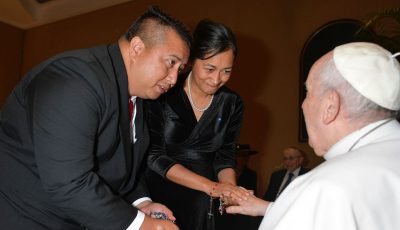Either/Or vs Vive la difference
I remind my Chinese ward that to agree and disagree is not the only option. The French taught me that one could agree and differ, then celebrate vive la difference!
In Refaluwasch Lino Olopai’s Rope of Tradition, he recalls that the 6th grade graduate of elementary school was one time worried about not having enough credentials to hold a position with the U.S. Peace Corps. He turned out to be an invaluable PCV asset in the Carolinian language as writer and pedagogue. Lino is an “and/both.”
My eldest commutes from Tar Heel country to Boston. She has a BA major closer to cultural anthropology than management of digitized database. She holiday time with us in DC and found herself sorting hardcopies of her office’s db, so she mastered Microsoft’s Access and segued to Oracle. Now, she attends Oracle’s annual to-do in San Francisco, elbowing with the likes of company founder Larry Ellison who now virtually owns Lanai of Hawaii.
I was recently disqualified to teach at NMC on the basis of a BA from a Philippine college. A mindset of “either/or” deficiency made the judgment. I was ready to write syllabi for English courses I was to teach in four days but the lady “going by the books” on WASC accreditation could not see the logic of allowing a greater variety and scope of outcomes other than a rigid “either/or” of the rule on onionskins. The conjunctive correlative of “both/and” is more useful in the real world.
A rigid adherence to deciding only on the basis of two options may be neat and clean, particularly when what is required is simply an “aye” or a “nay” for certain acts. Like in response to “are you with me or not,” it involves an ultimate choice where further reason is not required. A decision of “yes or no” is sufficient.
But in other instances, multiple variations apply. “Are you with me or not” sometimes involves an “if”, like how a lady wishes to appear and be perceived at a peer party, or a young man longs to first comb his hair before being seen in public. Distance between impressions of the sense and the imperative to act is replete with strongly felt emotions and deep thoughts seriously held; “either/or” choice is not always appropriate.
Danish Søren Kierkegaard, who keeps Hillary Clinton’s vocabulary current, penned two volumes of Either/Or that got the phrase into the English idiom. The choice he saw was between the hedonist (sensual) and the aesthete (moral), and Søren as a philosopher and theologian found the two incompatible. Existence and essence were philosophical lingo of his time. “Existential” combines the two with a “leap of faith” that characterized Søren’s maturity before he died.
Philosophical discourse is not our immediate interest. How we decide our choices is. Human knowledge has advanced enough that on just the structure of the brain, the sense impression (the medulla oblongata starts the sensual process) that leads to preferences from previous experiences (emotions and feelings nursed around the cerebellum) and the dialogue with others (ideas and thoughts in the cerebrum) are bridges to cross before the body goes into a willful act. “Beliefs” is in the borderline of emotion and cognition.
Kim Davis of Kentucky goes by belief; Monsignor Krzysztof Charamsa of Polish descent, of late a Vatican functionary, forced the papacy, in the light of Pope Francis’ deft touch on same-sex relations, to publicly acknowledge that among the clergy are gays, himself included, parading his partner in the process. For his deed, he was fired; he violated his celibacy vows and was “irresponsible” to make a matter of moral sensitivity public. Of course!
Thus, “either/or” by itself is no longer adequate as a means of decision-making. The French painfully learned their lesson on the shades of differences when they ran their colonies in Indochina. Vive la difference, an ethos in the arts and humanities of Paris, differed with what the gendarmes in Vientiane dealt with. Indochina preferred clean and neat orders that did not sit well with the reality of messy democracy.
Blame making is an area where “either/or” is a methodological giant. Tinian Dynasty’s staying open was premised on license renewal. BSI investments under the PR of “integrated resort” hope to avoid an “either-or” dichotomy.
Saipan is not gung-ho on ripping off Chinese gamblers. Limited foray to island casinos is not very promising from a business perspective, in my view; there are more workers on the floor as there are players.
The referenda that defeated casino gambling twice did not stick as the sad history of one-armed bandits in every village was outshone by the allure of mucho dinero, padrino.
Authentic life is more than playing a game of chance. Polarized choices are dichotomies with false pretenses. We uphold differences even if the casinos hold the advantage on simple odds. You may roll the dice now, please.

























